 W
WThe Battle of Brașov was fought on July 17, 1603, between the troops of Wallachia led by Radu Șerban and the Habsburg Monarchy on one side and the Transylvanian troops led by Mózes Székely on the other side.
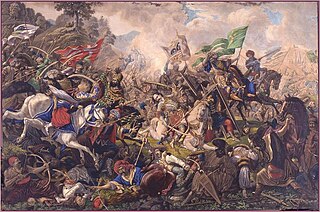 W
WThe Battle of Breadfield was the most tremendous conflict fought in Transylvania up to that time in the Ottoman–Hungarian Wars, taking place on October 13, 1479, on the Breadfield near the Saxon village of Alkenyér next to the Maros (Mureş) river. The Hungarian army was led by Pál Kinizsi, István Báthory, Vuk Branković, and Basarab Laiotă cel Bătrân.
 W
WThe Battle of Călugăreni was a battle in the history of early modern Romania. It took place on 23 August 1595 between the Wallachian army led by Michael the Brave and the Ottoman army led by Koca Sinan Pasha. It was part of the Long War, fought between Christian and Ottoman forces at the end of the 16th – beginning of the 17th centuries.
 W
WThe Battle of Finta was a confrontation between Prince Matei Basarab's Wallachian army and a combined Moldavian–Cossack–Tatar force under Prince Vasile Lupu and Tymofiy Khmelnytsky. It took place around Finta, now a commune in Dâmbovița County, Romania.
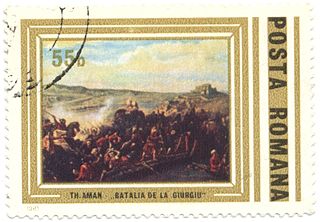 W
WThe Battle of Giurgiu took place on 27–30 October 1595. It was part of the Long War (1591/1593–1606), a border conflict between the Habsburg Monarchy and the Ottoman Empire over Balkan territories.
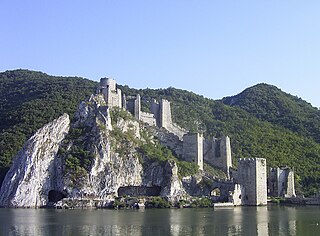 W
WThe siege of Golubac was a military conflict between the Hungarian–Wallachian–Lithuanian alliance and the Ottoman Empire in May 1428. This siege was the first battle in Hungarian military history in which the Hungarian army used significant artillery. However, they could not capture Golubac and were defeated by the Ottoman main army, led by Sultan Murad II. After the battle, most of Serbia and Bosnia was conquered by the Ottoman Army.
 W
WThe Battle of Guruslău or Battle of Goroszló was fought on 3 August 1601, between the troops of the Habsburg Monarchy led by Giorgio Basta, the Cossacks and Wallachia led by Michael the Brave on one side, and the Transylvanian troops led by Sigismund Báthory on the other side. It was part of a series of military encounters between the Ottoman Empire and opposing European states during 1591–1606.
 W
WThe Battle of Khotyn or Battle of Chocim or Hotin War was a combined siege and series of battles which took place between 2 September and 9 October 1621 between a Polish-Lithuanian army with Cossack allies, commanded by the Grand Hetman of Lithuania Jan Karol Chodkiewicz, and an invading Ottoman Imperial army, led by Sultan Osman II, which was stopped until the first autumn snows. On 9 October, due to the lateness of the season and heavy losses - due to failed assaults on Commonwealth fortifications - the Ottomans abandoned their siege and the battle concluded with a stalemate, which is reflected in the treaty where some sections favour the Ottomans while others favoured the Commonwealth. Chodkiewicz died on 24 September 1621 shortly after concluding a treaty with the Turks.
 W
WThe Battle of Khotyn or Battle of Chocim or Hotin War was a battle on 11 November 1673, where the forces of the Polish–Lithuanian Commonwealth under hetman John Sobieski defeated Ottoman Empire forces led by Hussain Pasha. It reversed the fortunes of the previous year, when Commonwealth weakness led to the signing of the Treaty of Buchach, and allowed John Sobieski to win the upcoming royal election and become the king of Poland.
 W
WThe Second Battle of Kosovo was a land battle between a Hungarian-led Crusader army and the Ottoman Empire at Kosovo Polje. It was the culmination of a Hungarian offensive to avenge the defeat at Varna four years earlier.
 W
WThe Battle of Kulevicha, also known as the Battle of Kulevcha or Kulewtscha, was fought during the Russo-Turkish War, 1828-1829 on 11 June 1829 between Russia and the Ottoman Empire.
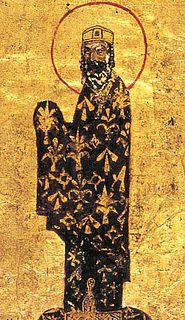 W
WThe Battle of Levounion was the first decisive Byzantine victory of the Komnenian restoration. On April 29, 1091, an invading force of Pechenegs was crushed by the combined forces of the Byzantine Empire under Alexios I Komnenos and his Cuman allies.
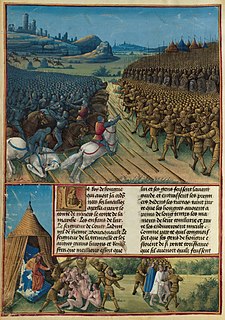 W
WThe Battle of Nicopolis took place on 25 September 1396 and resulted in the rout of an allied crusader army of Hungarian, Croatian, Bulgarian, Wallachian, French, Burgundian, German, and assorted troops at the hands of an Ottoman force, raising the siege of the Danubian fortress of Nicopolis and leading to the end of the Second Bulgarian Empire. It is often referred to as the Crusade of Nicopolis as it was one of the last large-scale Crusades of the Middle Ages, together with the Crusade of Varna in 1443–1444.
 W
WThe Night Attack at Târgoviște was a battle fought between forces of Vlad III, Prince of Wallachia, and Sultan Mehmed II of the Ottoman Empire on Thursday, June 17, 1462. The battle started after Mehmed, who already had tense relations with Vlad, discovered his alliance with Hungary's king Matthias Corvinus and ordered his forces to ambush him. Vlad foiled the attack and invaded Bulgaria. In response, Mehmed raised a great army with the objective to conquer Wallachia and annex it to his empire. The two leaders fought a series of skirmishes, the most notable one being the Night Attack where Vlad attacked the Turkish camp in the night in an attempt to kill Mehmed. The assassination attempt failed and Mehmed marched to the Wallachian capital of Târgoviște, where he found a few men with cannons. After leaving the capital, Mehmed discovered 23,844 impaled Turks whom Vlad had killed during his invasion of Bulgaria. The number is mentioned by Vlad himself in a letter to Matthias Corvinus. The sultan and his troops then sailed to Brăila and burned it to the ground before retreating to Adrianople. Both sides claimed victory in the campaign and Mehmed's forces returned home with many captured slaves, horses, and cattle.
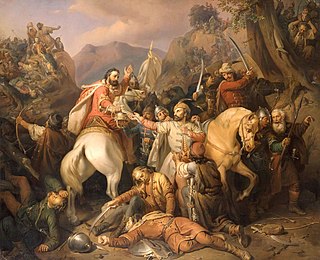 W
WThe Battle of Posada was fought between Basarab I of Wallachia and Charles I of Hungary.
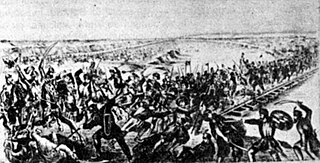 W
WThe Battle of Rovine took place on 17 May 1395. The Wallachian army led by Voivod Mircea cel Bătrân opposed the Ottoman invasion personally led by Sultan Bayezid I the Lightning. The Turkish force heavily outnumbered the Wallachian troops. The legend says that on the eve of the battle, dressed as a peace emissary, Mircea cel Bătrân talked to Bayezid asking him to leave Wallachia and promising him safe passage back. The Sultan proudly insisted on fighting.
 W
WThe Battle of Saint Gotthard, of the Austro-Turkish War (1663–1664), took place on 1 August 1664 on the Raab between Mogersdorf and the Cistercian monastery St. Gotthard in German West Hungary. It was fought between Imperial Army forces, including Germans, Swedish and French contingents, led by Imperial Commander in Chief Count Raimondo Montecuccoli and the army of the Ottoman Empire under the command of Köprülü Fazıl Ahmed Paşa.
 W
WThe Battle of Șelimbăr, or Battle of Sellenberk, took place on 18 October 1599 between the Romanian army of Michael the Brave and the Transylvanian-Hungarian army of Andrew Báthory. The battle was fought near the village of Șelimbăr close to Sibiu.
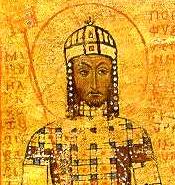 W
WThe Battle of Sirmium, Battle of Semlin or Battle of Zemun was fought on July 8, 1167 between the Byzantine Empire, and the Kingdom of Hungary. The Byzantines achieved a decisive victory, forcing the Hungarians to sue for peace on Byzantine terms. The battle consolidated Byzantine control of the western Balkans.
 W
WThe Battle of Cecora was a battle during the Polish–Ottoman War (1620–21) between the Polish–Lithuanian Commonwealth and Ottoman forces, fought from 17 September to 7 October 1620 in Moldavia, near the Prut River.
 W
WThe Battle of Valea Albă, also known as the Battle of Războieni or the Battle of Akdere, was an important event in the medieval history of Moldavia. It took place at Războieni, also known as Valea Albă, on July 26, 1476, between the Moldavian army of Ștefan cel Mare and an invading Ottoman army which was commanded personally by Sultan Mehmed the Conqueror.
 W
WThe Battle of Varna took place on 10 November 1444 near Varna in eastern Bulgaria. The Ottoman Army under Sultan Murad II defeated the Hungarian–Polish and Wallachian armies commanded by Władysław III of Poland, John Hunyadi and Mircea II of Wallachia. It was the final battle of the Crusade of Varna.
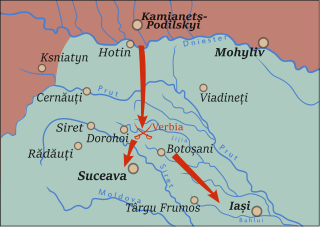 W
WThe Battle of Verbia was the decisive episode in Iacob Heraclid (Despot)'s invasion of Moldavia, taking place on November 18, 1561. Heraclid and Olbracht Łaski's army was backed by the Holy Roman Empire and possibly also by the Knights Hospitaller; it comprised foreign mercenaries, including Spaniards armed with arquebuses, making this the first battle in Moldavian history to be won by superior firepower. The Moldavian military forces under Prince Alexandru Lăpușneanu were backed by Janissaries, but lost crucial support from the cavalry when commander Moțoc defected to the enemy. From the village of Verbia, located outside Dimăcheni, Heraclid's Hungarian troops stormed into Botoșani, slaughtering the surviving Janissaries.
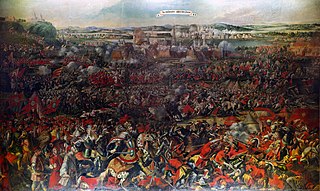 W
WThe Battle of Vienna took place at Kahlenberg Mountain near Vienna on 12 September 1683 after the imperial city had been besieged by the Ottoman Empire for two months. The battle was fought by the Holy Roman Empire led by the Habsburg Monarchy and the Polish–Lithuanian Commonwealth, both under the command of King John III Sobieski, against the Ottomans and their vassal and tributary states. The battle marked the first time the Commonwealth and the Holy Roman Empire had cooperated militarily against the Ottomans, and it is often seen as a turning point in history, after which "the Ottoman Turks ceased to be a menace to the Christian world". In the ensuing war that lasted until 1699, the Ottomans lost almost all of Hungary to the Holy Roman Emperor Leopold I.